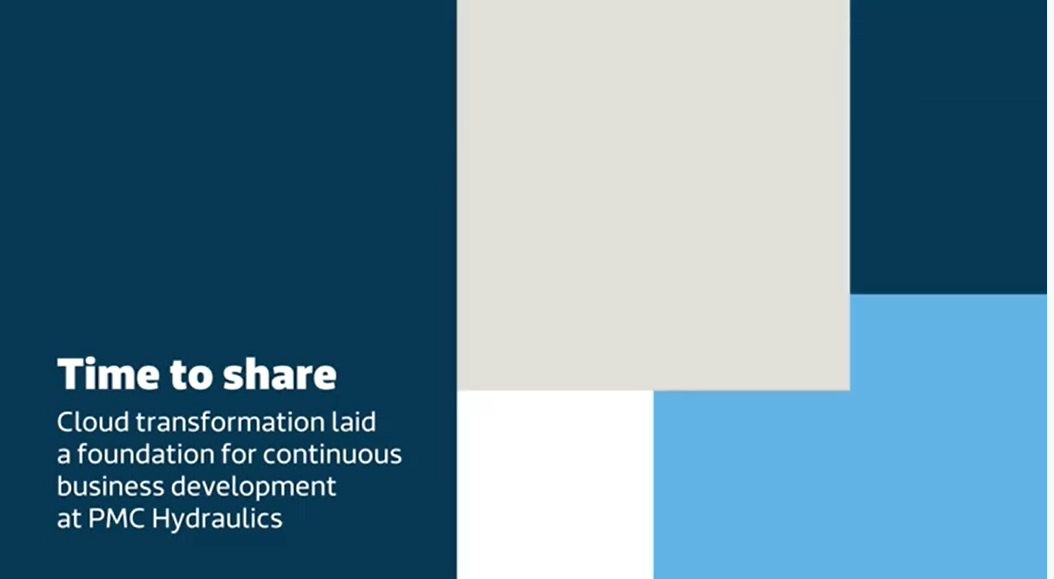PMC Hydraulics recently switched from its previous generation ERP system to a cloud service solution. This system transformation was of significant size because it harmonised operations in five operating countries at once.
The successful result was guaranteed by the joint steps taken with Microsoft and TietoEVRY, which had already been discussed and agreed upon before the start of the implementation.
PMC Hydraulics is the Nordic leader in innovative hydraulic systems and components for customers in the industrial, energy, mobile, and marine sectors. The company is headquartered in Helsingborg Sweden and has operations in eight countries, five of which were initially upgraded to the cloud ERP.
Previously, the company's ERP system was tailored to suit the needs of different operating countries. In the transformation, it was essential to standardise and coordinate the use of ERP in the five countries.
We first discussed whether to transform the entire system or whether we would be satisfied with improving our current ERP. The transition to the cloud raised doubts at the beginning, but we decided on this solution because it offers much more development potential in the future, PMC CIO Anders Bäckman explains in the webinar.
When the project started three years ago, doubts concerning cloud services were still somewhat justified because of fairly new technology and rapid pace things develop in IT. Now, however, PMC has made the move to cloud services and that have proven that these concerns were unfounded. In addition to enterprise-level processes and functionalities, Microsoft cloud services have evolved as the most trusted and secure platform in the market, emphasizes Senior Technical Specialist at Microsoft Antti Koikkalainen.
Together with system vendor Microsoft and consulting partner TietoEVRY, PMC decided to upgrade the ERP system to Microsoft Dynamics 365 cloud service. It was clear to all three parties where we are heading as a company and which steps to take to accommodate this growth. A consensus was soon formed as a team and with a common understanding, it was easy to start implementing the plan, says Heikki Alho, Head of Microsoft Dynamics Global at TietoEVRY.
Cooperation between the parties worked through dialogue and discussion. It was critical that all business representatives were involved in the discussions from the beginning and that all PMC stakeholders and partners understood that the goal is to harmonise operations.
Eight months of effort
The whole process took eight months. On TietoEVRY's side, about ten experts were involved in the implementation. On PMC’s side, the project involved about 30 people – in addition to IT experts, administration staff and naturally, the main users of the ERP.
Microsoft contributed to the rapid implementation of the project.
We want to be there with our clients when the services are implemented. We will meet with the parties and share best practices for implementation. All of us at Microsoft are there making sure that everything goes according to expectations and that the best features are included, says Antti Koikkalainen.
Heikki Alho of TietoEVRY emphasizes that cloud-based ERP is not functionally that different, but the entire set-up and system creation are different from those in on-prem. Despite the scale of the project, deployment progressed smoothly in five countries, thanks to the dialogue with all parties.
The client was adamant that we have to stick to the standard solution in the solution modelling phase. With wide implementation in five countries, there were only 13 modifications, that's all, he says.
I have been involved in many global ERP and IT projects in general, but they have rarely been as successful as this joint project, Anders Bäckman says.
Not by forcing but by discussion and realisation
However, it was hard work to get everyone in five different countries to buy into the transformation - this was achieved not by dictating, but by communicating and helping people to understand that this is the best possible solution.
Bäckman says that the challenge was by no means the technology, but the biggest effort was made to get everyone to accept the cloud transformation and understand what we were doing. After all, the functionalities for the end-user are the same.
The IT department is not the primary user of the ERP, it is principally used by the owners of the various processes and people working in the business units, so they must be motivated to develop their skills and learn.
CIO Anders Bäckman lists four key factors for success:
- Mindset, what you want to achieve and having staff commitment to the transformation
- Understanding what we already have and what we really require in the new ERP system
- TietoEVRY also had clear goals for what we needed at PMC. No changes were made to the standard solution without prior agreement with company representatives.
- Cloud-based ERP with new features available on a fast schedule
The transformation is the starting point for future development. The next steps include the implementation of the new ERP to three of our eight other operating countries, says Anders Bäckman.
The transition to the cloud is constantly paving the way for new solutions and upgrades as we evolve, concludes Heikki Alho of TietoEVRY.
I have been involved in many global ERP and IT projects in general, but they have rarely been as successful as this joint project.
Anders Bäckman, PMC Hydraulics
Watch the recording!

Video is blocked
Heikki is managing the Microsoft Dynamics 365 business at Tieto. His team is committed to help customers in their cloud transformation, having proven delivery model, industry competence and unparalleled experience in delivering Microsoft Dynamics 365. Heikki has personal experience of helping dozens of customers across Nordics to transform their business by implementing new business platforms, starting from consultative sales going all the way to managing successful deliveries and continuous development.